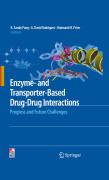
Enzyme- and transporter-based drug-drug interactions: progress and future challenges
Pang, K. Sandy
Rodrigues, A. David
Peter, Raimund M.
Germination of the thought of 'Enzymatic- and Transporter-Based Drug-Drug Interactions: Progress and Future Challenges' Proceedings came about as part of the annual meeting of The American Association of Pharmaceutical Scientists (AAPS) that was held in San Diego in November of 2007. The attendance of workshopby more than 250 pharmaceutical scientists reflected the increased interest in the area of drug-drug interactions (DDIs), the greater focus of PhRMA, academia, and regulatory agencies, and the rapid pace of growth in knowledge. One of the aims of the workshop was to address the progress made in quantitatively predicting enzyme- and transporter-based DDIs as well as highlighted areas where such predictions are poor or areas that remain challenging for the future. Because of the serious clinical implications, initiatives have arisen from theFDA (http://www.fda.gov/cber/gdlns/interactstud.htm) to highlight the importance of enzyme- and transporter-based DDIs. During the past ten to fifteen years, we have come to realize that transporters, in addition to enzymes, play a vital role in drug elimination. Such insight has been possible because of the continued growth in PK-ADME (pharmacokinetics-absorption-distribution-metabolism-excretion) knowledge, fueled by further advances in molecular biology, greater availability of human tissues, and the development of additional and sophisticated model systems and sensitive assay methods for studying drug metabolismand transport in vitro and in vivo. This has sparked an in-depth probing intomechanisms surrounding DDIs, resulting from ligand-induced changes in nuclearreceptors, as well as alterations in transporter and enzyme expression and function. Despite such advances, the in vitro and in vivo study of drug interactions and the integration of various data sets remain challenging. Therefore, it has become apparent that a proceeding that serves to encapsulate current strategies, approaches, methods and applications is necessary. As Editors, we have assembled a number of opinion leaders and asked them to contribute chapters surrounding these issues. Many of these are the original Workshop speakers whereas others had been selected specially to contribute on topics related to basic and applied information that had not been covered in other reference texts on DDI. The resulting tome, entitled Enzyme- and Transporter-Based Drug Interactions: Progress and Future Challenges, comprises of four sections. Twenty-eight chapters covering various topics and perspectives related to the subject ofmetabolic and transporter-based drug-drug interactions are presented. INDICE: Enzymatic Basis Of Phase I And Phase II Drug Metabolism.- Transporters: Importance In Drug Absorption, Distribution And Elimination.- ADME Pharmacogenetics and Its Impact on Drug-Drug Interactions.- Impact Of Nuclear Receptors, CAR, PXR, FXR, And VDR, And Their Ligands On Enzymes And Transporters.- Impact of Physiological Determinants: Flow, Binding, Transporters And Enzymes On Organ and Total Body Clearances.- In Silico Approaches to Predict Drug-DrugInteractions.- In Vitro Techniques To Study Drug-Drug Interactions Of Drug Metabolism: Cytochrome P450.- In Vitro Characterization Of Inhibitory Drug-Drug Interactions Involving UDP-Glucuronosyltransferase.- In Vitro Techniques To Study Transporter-Based Drug-Drug Interactions.- In Vitro Techniques To Study Drug-Drug Interactions Involving Transport: Caco-2 Model For Study Of P-Glycoprotein And Other Transporters.- Use Of In Vivo Animal Models To Assess Drug-DrugInteractions.- Extrapolation of In Vitro Metabolic and P-Glycoprotein-mediated Transport Data To In Vivo By Modeling and Simulations.- Translation Of In Vitro Metabolic Data To Predict In Vivo Drug-Drug Interactions: IVIVE And Modeling And Simulations.- Absorption Models To Examine Bioavailability And DDI’s InHumans.- Management Of Drug Interactions Of New Drugs In Multicenter Trials Using The Metabolism & Transport Drug Interaction Database©.- Web-Based Database As A Tool To Examine Drug-Drug Interactions Involving Transporters.- Drug Disposition And Drug-Drug Interactions: Importance Of First-Pass Metabolism In Gut And Liver.- Transporter Based Drug-Drug Interactions And Their Effect On Distribution Volumes.- Inactivation Of Human Cytochrome P450 Enzymes And Drug-Drug Interactions.- Allosteric Enzyme And Transporter Based Interactions.- Interplay Of Transporter-Drug Interaction: Complications Of Both Inhibitory AndInductive Events In Drug-Drug Interaction.- Herbal Supplement-Based Interactions.- Anticipating And Minimizing Drug Interactions In A Drug Discovery And Development Setting: Industrial Perspective.- Clinical Studies Of Drug-Drug Interactions: Design And Interpretation.- Toxicological Consequences Of Drug Drug Interactions.- Complex Drug Interactions: Significance And Evaluation.- DDI: Labeling And Marketing Perspectives.- Drug-Drug Interactions: What Have We Learnt And Where Are We Going?
- ISBN: 978-1-4419-0839-1
- Editorial: Springer
- Encuadernacion: Cartoné
- Páginas: 616
- Fecha Publicación: 01/12/2009
- Nº Volúmenes: 1
- Idioma: Inglés
